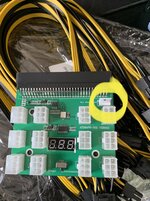Jahead
Experte
- Mitglied seit
- 01.05.2021
- Beiträge
- 1.613
- Ort
- HB
- Details zu meinem Desktop
- Prozessor
- Ryzen 7 5800X
- Mainboard
- MSI Tomahawk Max 2
- Kühler
- MO-RA3 420 + TechN CPU-Kühler + (inside) Liquid Freezer II 420 radiator only
- Speicher
- 32 GB (4* 8GB) G.Skill RipJaws V schwarz DDR4-3200 DIMM CL16-18-18-38
- Grafikprozessor
- EVGA 3090 FTW3 Ultra Gaming + Wakü + Cooler Master vertical GPU Kit 2.0
- Display
- 2x 28 Zoll BenQ EL2870U
- SSD
- 2
- Gehäuse
- SILENT BASE 802 Window Black
- Netzteil
- 1200 Watt Corsair HX1200 Platinum
- Keyboard
- Logitech G512 mechanische Gaming-Tastatur, GX Red Linear Switches
- Mouse
- Logitech G603 LIGHTSPEED kabellose Gaming-Maus & Logitech G440 Gaming-Mauspad
- Betriebssystem
- WIN 11
- Sonstiges
- 2* Yamaha HS5 (XLR-Kabel) + Focusrite 2i2 Audiointerface + Rode NT1-A Großmembranmikrofon & Rode PSA Mikrofonarm, Logitech G432 kabelgebundenes Gaming-Headset
QuelleWas glaubt Ihr, was die maximale Kabellänge ist, bis man es an der Hashrate merkt?
edit: Hhhmmm, ok - wie wir also wissen, wissen wir nichts, beste wäre ausprobieren und berichten...There are rumors that PCIe to USB 3.0 specifications only allow 24 inch cable length, which some attribute to the fact that most PCIe risers come with 24 inch cables. However, unlike previous USB standards, official USB 3.0 specifications don’t include any cable length limitations – it simply requires cabling that meets electrical specification. Thus, if a USB cable has AWG 26 copper wires, the maximum practical length for the riser cables would be 4.3 feet (1.3 meters).
Also keep in mind that interference can occur easier in longer cables. I have a USB 3.0 cable for my printer that is 20 feet long, and I don’t have any issues. If I coiled it up around my subwoofer though I could see it having issues.


edit²:
Kann auch troll sein.
Zuletzt bearbeitet:



 ), weil ich meine Gamer Dudes ärgern will oder kein Bock auf unsere Umwelt habe... Dabei macht das basteln und optimieren mehr Laune als alles andere. Wenn das Rig steht und tut, ist direkt langweilig und neue Hardware muss her. Man lernt echt so viel.... ich glaube, das ist eine Art Sucht, oder? 😁
), weil ich meine Gamer Dudes ärgern will oder kein Bock auf unsere Umwelt habe... Dabei macht das basteln und optimieren mehr Laune als alles andere. Wenn das Rig steht und tut, ist direkt langweilig und neue Hardware muss her. Man lernt echt so viel.... ich glaube, das ist eine Art Sucht, oder? 😁
